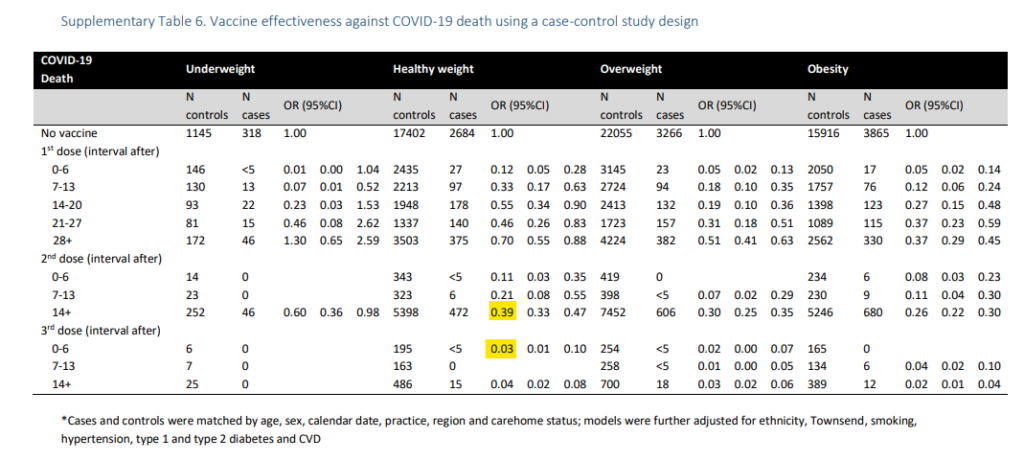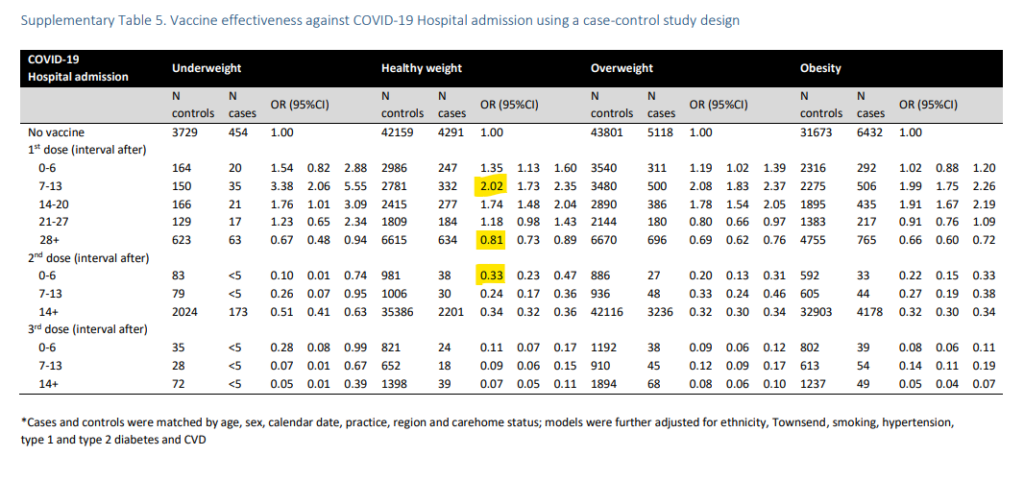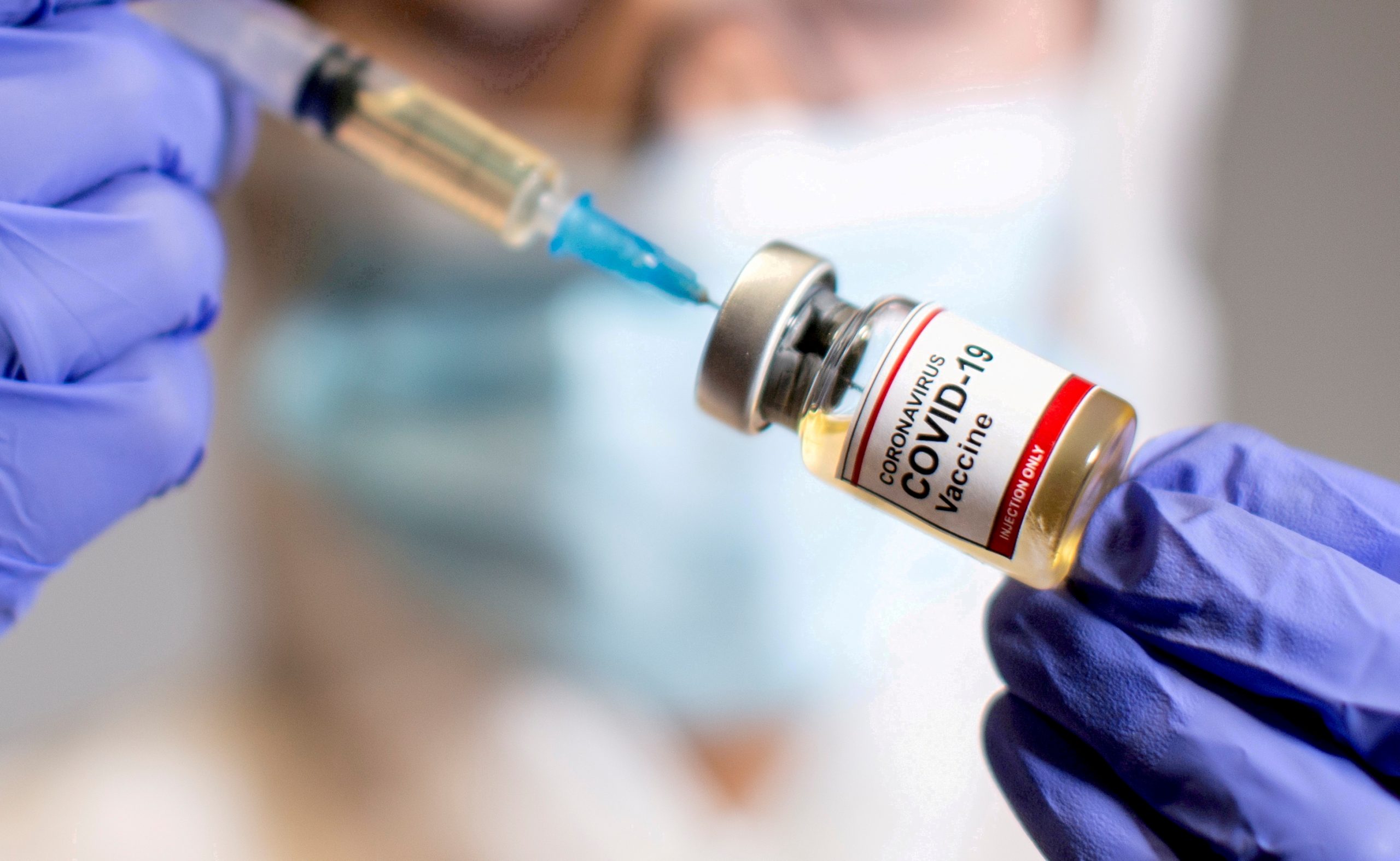People who received two doses of COVID-19 vaccine were 44% more likely to be infected, a study from Oxford University has found, contradicting the basis of global vaccine policy, which assumes vaccination significantly cuts incidence and transmission.
The study, published in the Lancet, looked at all infections reported in England among adults registered at a medical practice from December 8th 2020 to November 17th 2021, meaning it spanned the Alpha and Delta periods. It used a case-control design to estimate vaccine effectiveness, allowing potential confounding factors such as age, sex and underlying conditions to be controlled for, while individuals with prior infection were excluded.
The results for effectiveness against positive Covid test (i.e., reported infection), which were found buried away in the supplementary appendix, are shown below.

I’ve highlighted in yellow three key figures. The top two show that in the two weeks following the first jab individuals were three to four times more likely to test positive for Covid than their unvaccinated counterparts. This is further confirmation of the post-jab spike in infections that has often been noted and which there is evidence is a result of the vaccination temporarily reducing immunity.
The third figure shows that two weeks or more after the second jab – which during 2021 was regarded as ‘fully vaccinated’ – individuals were 44% more likely to be infected than their unvaccinated counterparts. This is negative vaccine effectiveness (where infections are higher in the vaccinated than the unvaccinated) of minus-44%. This negative effectiveness is in line with what was seen in the raw data from England at the time and also in studies from other countries, but contradicts the Government’s official estimates, which claimed effectiveness to be 60-85% against Delta infection. The new study indicates that the negative effectiveness was not just a result of confounding factors or a ‘catch-up’ effect, where the vaccinated have lower infection rates initially then higher infection rates as the effect of the vaccine wears off, as some have claimed.
Acknowledging the figures, the authors write: “Surprisingly, we observed a higher risk of test positivity after vaccination with one or two doses across all BMI groups, which is contrary to evidence reported by the U.K. ONS.” What they don’t mention is that it is fully in line with data from the UKHSA, nor that the ONS is known to overestimate infection rates in the unvaccinated because it underestimates the population – the ONS puts the unvaccinated adult population at 8% whereas the NIMS database puts it at 19% (and surveys higher still at 26%).
The authors state that the “hospital admission and death outcomes were considered more robust outcomes than infection” owing to “variability in testing” and a potentially “high proportion of asymptomatic infections”. The implication is that unvaccinated people were less likely to get tested when infected, suppressing the positive test rate in the unvaccinated. No evidence is provided for this claim, however, nor any attempt made to quantify the possible size of the difference.
The study was published in June but went largely unnoticed until Alex Berenson wrote about it last week. Alex also draws attention to the fact that vaccine effectiveness against hospitalisation and death is much weaker than was claimed at the time.

Vaccine effectiveness against death 14 or more days after the second jab is just 61% (the first highlighted figure), well below the 90-99% claimed by the Government. Note that the overall protection will be even lower owing to the vaccinated being more likely to be infected: the 44% higher infection rate mentioned above would reduce the 61% effectiveness to just 34%.
Oddly, the vaccine effectiveness against death in the week following the third jab (the second highlighted figure) jumps up to 97%, from 61% following the second jab, despite this being before the effect of the booster should kick in. This oddity is not explained.

Looking at the hospitalisation figures, there is a disturbing spike in the weeks following the first jab, hitting over twice as high (2.02) in the second week. Why are the vaccinated up to twice as likely to be hospitalised with Covid than the unvaccinated in the weeks following the jab?
The figures show that having two vaccine doses reduces hospitalisation risk by 66% once 14 days post-injection (though once again there is an unexplained leap in efficacy from 19% 28 days after dose 1 to 67% in the week after dose 2). The 66% is markedly lower than the 90-99% claimed at the time, as shown below in the table from a UKHSA Government report in September 2021.
The new figures are much more in line with what was observed in the raw UKHSA data. But it means we’re left without explanation as to why the clinical trials and Government studies showed high efficacy for a two dose course, when observational studies of the real-world evidence now find negative effectiveness against infection and much lower than advertised effectiveness against serious disease. An explanation is clearly required. And given the earlier studies were used to inform both individuals’ choices and public policy, including medical coercion, serious lessons need to be learned.













To join in with the discussion please make a donation to The Daily Sceptic.
Profanity and abuse will be removed and may lead to a permanent ban.
Well it’s a sluggish start in the U.S for the new bivalent booster;
https://www.nbcnews.com/health/health-news/updated-covid-booster-shots-doses-administered-cdc-rcna48960
And it’s an “unenthusiastic vaccination turnout” here in tiny Netherlands so far. Long may this lack of uptake and compliance with this irrational nonsense continue!
https://nltimes.nl/2022/09/28/rivm-new-covid-restrictions-despite-rising-cases-nl-unprepared-sharp-increase
Let’s hope Dr Scott Roberts of Yale Medicine continues to be demoralised by the low uptake. I wonder how much money Yale Medicine make from COVID-19 vaccines?
Yes indeed. If I wanted to feel demoralized I’d don a flipping mask! Never again. Incidentally, I read a while back somewhere that the UK are getting a Covid/flu/RSV combo jab for this winter but I’ve not heard anything more about it so perhaps this was fake news. Do you or anybody else on here know if this is true? Are they going to bring out a mRNA triple whammy flu shot? Can’t remember where I read that now….
Do you mean this “vaccine”?
mRNA-1010 Quadrivalent Influenza Vaccine — Precision Vaccinations
I’m not going near mRNA anything from now on. They can stick where the UKHSA, MRHA and SAGE collectively talks out of.
Another interesting video released today. Watch it before YT cancels it.
(9) Safe and Effective: A Second Opinion (2022) LIVE PREMIERE | Oracle Films | News Uncut – YouTube
Thanks for this link
Wow, what a powerful documentary. I’ll be sharing the hell out of it. Thank you. In fact, I’m going to go share it on FB now and see if I can accomplish my 27th ban since this whole shitshow began!
Womp womp….
Well, the culprits are fairly unlikely to plead guilty. Policies made up on the hoof based on dodgy engineering have never been a good idea, at least not for the punters who are happy to buy the products. Another table worth examining would be the balance sheet of certain firms, notably Pfizer; they are probably looking quite positive at present.
Good grief, the explanation is well simple if one follows the $cience. The vaxx most certainly did pass the necessary trials – the profit margin trials, they were the only ones that mattered to big pharma and its government bagmen. Fool the people while the fooling is good, then take the money and run.
I look forward to a future study that confirms: 1) temporary reduction in immunity, 2) temporary minimal protection due to increased antibodies, 3) permanent reduction in immunity in people who have had 4 or more shots. It’s coming, hopefully followed by a proper reckoning.
“permanent reduction in immunity in people…”
That’s a useful euphemism for ‘deceased.’
Will, you deserve Secret Service protection for the services you are providing readers. It takes a dedicated and smart Truth Sleuth to parse all these studies and find the lede that’s almost always buried.
I wonder why
https://www.sciencedirect.com/science/article/pii/S027869152200206X
When oh when is PHE, sorry UK Health Security (sounds so much better) going to do its job.
Lol, I forget it’s just an enablier for the RPTB.
I pray they rot in hell.
Basically the mRNA jab trashes the recipients immune system.
It’s as simple as that.
Looks like Australia have a similar lack of enthusiasm for the latest booster. “Around the world, authorities are rethinking how they encourage maximum vaccine protection”. Or in other words, “Shit! We’ve spent millions on these new-fangled products and we’re not going to get shot of them before they expire because nobody wants them. Bring in the mandates!!”
The claptrap in this article…honestly!
https://medicalxpress.com/news/2022-09-millions-australians-havent-covid-boosters.html
I think we’ve seen the last of vaccine mandates. There’s just no public appetite for them. It failed. They had one chance to frighten the public into submission and blew it; I think they’ll quietly backtrack, regroup and think of new ways to control us!
Yes I hope so, though in some countries and US states I wouldn’t put it past them to try. For this latest bivalent booster anyway they surely wouldn’t have a leg to stand on legally. I mean, one word; mice!
Currently sleepless in a hotel in Bangkok, where all the staff proudly wear badges reassuring me that they’ve been ‘vaccinated’. Very sad to see. The scale of this crime is breathtaking.
Hey, good to see you again! I know you said some time back you were quite busy, I was wondering where you were.
Yes, the scale of the crime is breathtaking. Here in NL they want to stick it to everyone over 12 for a 4th time, the health minister is saying masks works, right after the head of the OMT said they don’t (again). And silence on the excess deaths, other than what looks like figure-fiddling by saying last week deaths went from excess to spot on target – except that was based on an estimate.
Outside of the staff badges, how are things in Thailand for the rest? Normal-ish?
I’m in the process of moving to Vietnam but have to wait in Thailand until my work permit is ready. We booked flights via Bangkok and had to cancel the final leg of the journey when my new employer told me the permit wouldn’t be ready in time. So this is an unexpectedly long stopover! From what I’ve seen, Thailand‘s population has been very badly propagandised. Masks are everywhere but there’s no logic to any of it. The unwritten rule seems to be you wear one if you’re working and/or if you’re indoors with strangers. It’s not mandated however and people seem to do it out of civic duty. I haven’t had any comments about my non compliance. They weren’t required on flights or at the airport. We decided to do ‘professional lateral flow tests’ at the last minute before travel but no asked to see our ‘certificates’ except at Heathrow! I hope Covid nonsense has faded more in Vietnam but I suspect it’ll be about the same….
HI CG, I think it must depend on where you are in Thailand. In Phuket apart from banks and immigration no-one wears masks routinely. There are still some who wear them when riding a motorbike but given the lack of vehicle maintainance this is understandable.
I did try to reply to your pm but I couldn’t find a way to do so. Sorry.
Have you sampled the delights of Soi Cowboy or Nana Plaza yet? 555555
Good luck with your move to Vietnam.
Lots of this kind of signage
You’ve just given me a blast from the past of this series I watched when I was a kid called ‘Bangkok Hilton’ with Nicole Kidman! haha..I’m sure your digs are a lot more comfortable though.
Yes I remember! And yes they are, thankfully! As I’ll be living in Vietnam I’m going to do one of those ‘postcards from’ write ups when I’ve settled in. I really hope there’s not that much to write about!
The Thais fell for the vaccine fantasy hook, line and sinker.
Isn’t it possible that the difference is due to the government calculation of VE is by excluding the 2-3 week period after vaccination, with the explanation that the vaccination hasn’t fully been enacted until that time frame has gone by?
This is the big issue with the debate around vaccine effectiveness, the fact that the real world consequences of taking the vaccine aren’t being included in the evaluation of its effectiveness. Of course the period of time directly after being vaccinated should count as part of the whole vaccination process. If you had not gotten vaccinated, then you would not be meeting that initial 2 week period of possible higher susceptibility to being infected.
Another aspect is that it’s quite possible and even likely that those who get vaccinated adjust their behavior after doing so, that is, they start taking on more risky behavior once vaccinated, compared to the unvaccinated. The only way to control for this is to do a proper RCT where those who are being vaccinated and not are not aware whether they are getting the actual vaccine or not.
A problem with this approach is that they still know that there’s a possibility of them having been vaccinated, which the unvaccinated don’t feel. Risk compensation will happen in people who have vaccinated themselves, especially when the media and government lure them into thinking that the vaccine is nearly 100% effective, and aren’t told that they could actually be more vulnerable in the 2 week period following the injection.
A RCT could test for this by having at least these groups:
Would group number 5 perhaps end up more like 1 and 2 as far as infection rate in the first 2 weeks? The government has been so scared of letting on that there is any downside with taking the vaccine that they are potentially making group 4 think they are invincible once they’ve taken the shot and then becoming more vulnerable for infection, serious disease and death as a result.
The more likely explanation is that bigpharma are bent.
They have numerous criminal convictions re falsifying data for approval -not that they need to falsify trials these days- as all regulatory bodies are giving them a free pass..
Bextra (Pfizer), Vioxx, Risperidone, Pandemrix. To name a few.
No jail time, just cop a plea for a criminal fine and add the cost to the next drug.
Pure genius.
And plenty of revenue in the meantime, especially for Pfizer. A figure was mentioned by Mark Steyn the other day, the exact amount of which I can’t be sure of, but I think it was around $37M so far.
More likely $37Billion I think.
Wow, talk about iatrogenic!